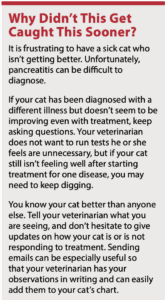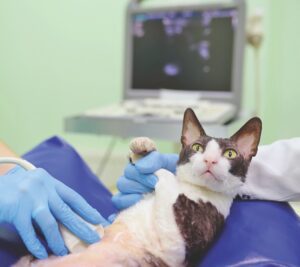Pancreatitis is a frustrating illness that can look like several other common cat problems. The biggest red flag for you as an owner should be if your cat stops eating or has a poor appetite, and this can be an emergency.
An Angry Pancreas
Your cat’s pancreas is a small organ located next to her stomach. The pancreas has many jobs and is part of both the digestive system and endocrine system. On the endocrine side of things, the pancreas produces insulin and other hormones. As for the digestive system, the pancreas produces enzymes needed to digest food. If the pancreas isn’t functioning properly, a lot of body processes can go wrong.


Why do cats develop pancreatitis? In 95% or more of cases, we don’t know. These cases are referred to as idiopathic pancreatitis. Idiopathic means that no cause for the disease is identified. Rarely, the parasitic infection Toxoplasmosis can be responsible.
In dogs, devouring a high-fat feast—like raiding the garbage or stealing all the drippings and trim from the Thanksgiving turkey—is a common trigger of pancreatitis. This does not appear to be the case for cats.
Acute vs. Chronic
Pancreatitis can be acute or chronic. The only way to tell the difference, other than presumptively from clinical signs, is with a biopsy of the pancreas. Acute pancreatitis tends to be more severe, while chronic cases are generally milder.
Most veterinarians and cat owners do not pursue a biopsy. While knowing if pancreatitis is chronic or acute is nice, it does not change the treatment plan. For many of us with sick cats, putting them through a surgical procedure to obtain a biopsy just isn’t worth it.
Chronic pancreatitis is the most common form in cats. It also usually comes along with other related diseases.
These may include:
- Cholangitis (inflamed gallbladder)
- Diabetes mellitus
- Hepatic lipidosis (fatty liver syndrome)
- Inflammatory bowel disease
Symptoms of Pancreatitis
The most common symptoms of pancreatitis are:
- Poor appetite
- Weight loss
- Dehydration
- Lethargy
- Vomiting
- Nausea (drooling, licking lips)
- Diarrhea
- Abdominal pain
- Yellowing of the skin and eyes
- Pale mucous membranes
A poor appetite, weight loss, and dehydration are the most common symptoms. These symptoms can suggest many different feline diseases, and your cat’s veterinarian will do a variety of tests to rule out different possibilities. It is common for a cat to be diagnosed with a more obvious illness, such as diabetes, first. Then, if the cat does not respond properly to treatment, additional testing will be done to find concurrent illnesses like pancreatitis.
Diagnostic Testing
Your veterinarian will start with a physical exam and will get a thorough history from you about what changes you have noticed in your cat and how long they have been going on.
Bloodwork is a mainstay for diagnosing many metabolic and digestive issues. Your veterinarian will likely start with a chemistry panel and CBC. These tests will give information about liver and kidney function, blood glucose, electrolyte balance, and anemia or signs of infection, among other issues. Importantly, the results of these tests may be normal in cats with pancreatitis.
If your veterinarian suspects pancreatitis may be at work, she will likely recommend a feline pancreatic lipase immunoreactivity (fPLI) test. The fPLI is not a perfect test for pancreatitis in cats, but it is the best we have. Some veterinary hospitals have a SNAP version of the test that can be run quickly in the exam room, but for greatest accuracy, the blood is usually sent to a lab. fPLI is specific to the feline pancreas, but it can still sometimes give a false negative result in mild cases of feline pancreatitis.
Abdominal ultrasound can help diagnose pancreatitis. A skilled ultrasonographer often will be able to see structural changes in the pancreas that are caused by the inflammation, especially in acute pancreatitis. An ultrasound is also a good opportunity to check on other organs in your cat’s abdomen at the same time.
X-rays are not usually helpful for diagnosing pancreatitis, but they can be used to rule out other health problems.
Treatment
There is no magic bullet to treat pancreatitis in cats. Instead, your cat’s veterinary team will focus on supportive care to help her feel better and ease her symptoms while she recovers.
There are four primary pillars of treatment:
- Nausea control
- Nutritional support
- Pain control
- Hydration support
- Nausea Control
Dogs with pancreatitis usually present with moderate to severe vomiting. Cats are more subtle. Some cats may vomit, but they are more likely to show signs of nausea such as poor appetite, drooling, or licking their lips.
Even if your cat with pancreatitis is not vomiting, your veterinarian will usually still prescribe antinausea meds. This is critical to promote a good appetite and help your cat feel better.
The most common antinausea medication for cats is Cerenia (maropitant). This medication can be given as an injection or a tablet.
Nutritional Support
Eating is critical for cats with pancreatitis. Cats who do not eat for even a few days are at risk of developing hepatic lipidosis, a dangerous and potentially fatal liver disorder. Your cat may need to be hospitalized to ensure that she is getting adequate nutrition and to prevent her from developing hepatic lipidosis.
If anti-nausea meds alone do not get your cat eating, your veterinarian may start her on an appetite stimulant such as mirtazapine.
Some cats require a feeding tube for a few days to provide nutrition until they are feeling better and able to eat on their own. Feeding tubes are usually well-tolerated. Your cat might need a feeding tube if she does not respond to an appetite stimulant, has been anorexic for several days, or is extremely sick.
What Diet?
Don’t get too hung up on exactly what your cat with pancreatitis is eating. The most important thing is that she is eating.
“I usually recommend something at 15% fat as a kibble and 4% or less in a canned food. This is as a precaution, as we don’t really know how fat affects pancreatic secretion in cats,” says Joseph Wakshlag, DVM, PhD, section chief of nutrition at Cornell University’s College of Veterinary Medicine.
We don’t know the best diet for a cat who just has pancreatitis. Most veterinarians recommend feeding foods that are tasty to help stimulate appetite, easy to digest, and high in protein and low in carbs. Your goal is to prevent hepatic lipidosis and combat weight and muscle loss.
Your cat’s nutrition plan will need to accommodate all illnesses or nutritional deficiencies, not just pancreatitis. For example, cats with diabetes mellitus usually do best on a low-carb canned diet. Cats with IBD may require a novel protein diet.
If your cat’s bloodwork shows elevated cholesterol levels, your veterinarian may recommend a low-fat diet. Omega-3 fatty acids can also be beneficial for these cats.
If your cat has low vitamin B12 levels, your veterinarian may recommend supplementing B12 in the diet or giving injections to boost her levels. These injections can be given in the veterinary clinic, or you can learn to give them at home.
Pain Control
Many cats with pancreatitis don’t seem to be in pain, but cats are notorious for hiding discomfort. Most veterinarians err on the side of providing pain control so that we are sure our cats with pancreatitis aren’t uncomfortable.
Cerenia provides some relief for abdominal pain as well. Other medications your veterinarian may prescribe include the opioid buprenorphine, gabapentin, or a fentanyl patch (for severe pain).
Hydration
Many cats with pancreatitis become dehydrated. If your cat has a mild case, she may only require a few rounds of subcutaneous fluids given under the skin. This can be done in the veterinary clinic or you can learn how to do it yourself at home (knowing how to administer sub-Q fluids is a great skill when you have a senior cat).
For cats who are severely dehydrated or ill, intravenous fluids in the hospital are the best option. A catheter will be placed so that fluids can be given directly into your cat’s vein. IV fluids are also a great way to help address electrolyte deficiencies. Once your cat is back at home, you can help promote hydration by adding water to her food and placing water bowls throughout the house.

Prognosis
Many cats can recover from a bout of pancreatitis and go on with their normal lives. Cats with milder cases generally do better than those who are severely ill.
Talk to your veterinarian about your cat’s unique case and the best way to support her health moving forward. Follow nutritional recommendations for any illnesses that she may have or be prone to, and monitor her appetite closely.
Joseph Wakshlag, DVM, PhD, is the section chief of nutrition and professor in the sections of clinical nutrition and sports medicine and rehabilitation at Cornell University’s College of Veterinary Medicine.



